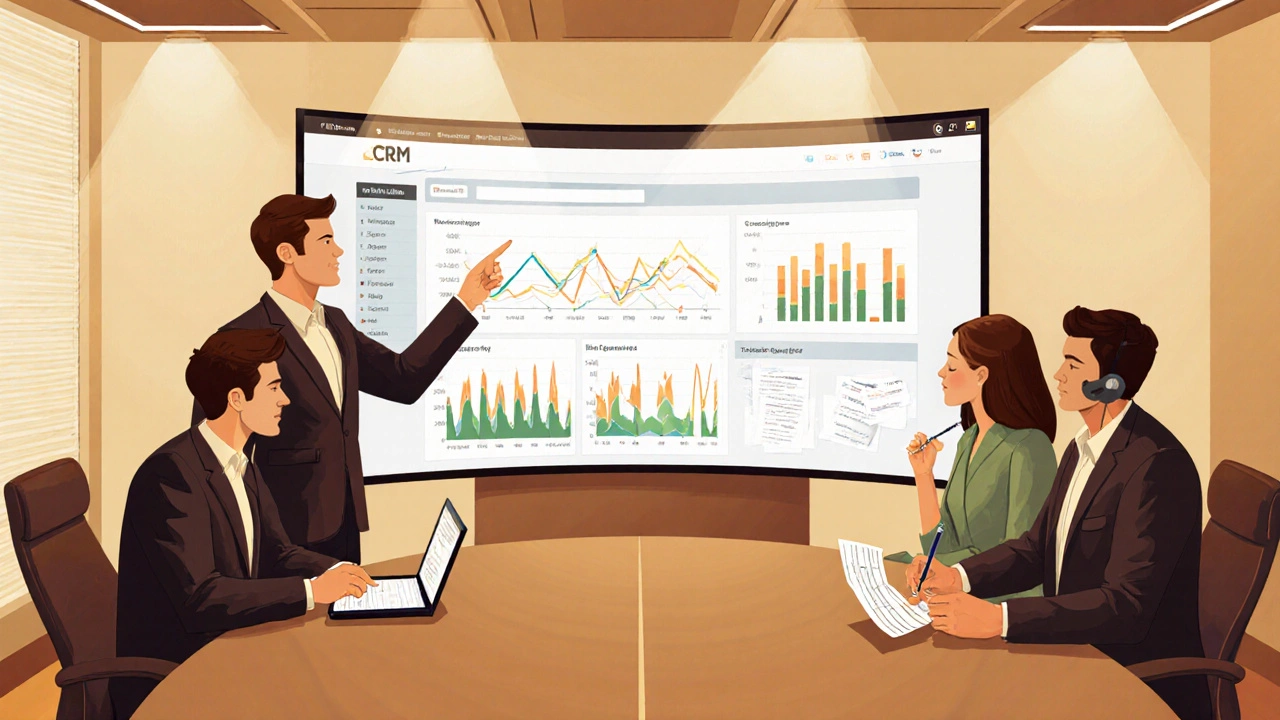When you hear someone mention the 3 C's of CRM, you might picture a buzzword list that never quite fits your daily workload. In reality, those three letters - Customer, Communication, Collaboration - are the backbone of any system that promises to turn data into lasting relationships. This guide breaks down each "C," shows how they link together, and gives you a practical roadmap to start using them right now.
What is CRM?
CRM is a software and strategy platform that helps businesses manage interactions with current and potential customers, streamline processes, and improve profitability. In the UK market, companies of every size rely on CRM to keep sales pipelines tidy, personalize marketing, and measure service quality. While the technology varies - from cloud‑based SaaS to on‑premise suites - the core goal stays the same: turn every touchpoint into useful insight.
The 3 C's Framework
The 3 C's framework was coined by sales and service leaders who needed a simple way to remember the three pillars that make a CRM truly effective. Think of it as a checklist that you can apply whether you’re evaluating HubSpot, Zoho, or a niche UK‑focused solution. Below is a quick snapshot of each component.
| Component | Key Goal | Typical Metrics | CRM Features Used |
|---|---|---|---|
| Customer | Know who you’re serving | Customer Lifetime Value, Segmentation Accuracy | Contact records, profile enrichment, segmentation tools |
| Communication | Deliver the right message at the right time | Open rate, response time, channel mix | Email templates, workflow automation, omnichannel inbox |
| Collaboration | Make teams work together seamlessly | Deal win‑rate, task completion, internal feedback loops | Shared dashboards, task assignments, notes & @mentions |
Customer: Building a Single Source of Truth
Customer is a person or organisation that buys or could buy your products or services, and whose data you store in the CRM. In practice, a solid customer profile includes contact details, purchase history, interaction logs, and behavioural scores. The moment you start consolidating this data, you gain a 360‑degree view that powers segmentation, personalization, and predictive analytics.
- Start with clean data - remove duplicates, verify email addresses, and standardise phone formats.
- Enrich records using third‑party APIs (e.g., Clearbit or UK Companies House) to add firmographics.
- Assign a clear owner to each record; accountability drives follow‑up quality.
When you treat the customer as a living entity rather than a static row, the rest of the CRM workflow becomes smoother.
Communication: Turning Data into Dialogue
Communication is a set of interactions - emails, calls, chats, social messages - that a business has with its customers, all tracked within the CRM. Modern CRMs let you automate follow‑ups, personalise content with merge fields, and route inbound queries to the right team member.
- Map the buyer’s journey - awareness, consideration, decision - and align messaging to each stage.
- Use workflow rules to trigger reminders, nurture emails, or task assignments based on behavioural triggers (e.g., a demo request).
- Measure outcomes: open rates, click‑throughs, and especially response times, which correlate strongly with conversion in UK B2B markets.
Effective communication doesn’t happen by accident; you need a strategy that the CRM can enforce at scale.
Collaboration: Uniting Sales, Marketing, and Service
Collaboration is a process where multiple internal teams share information, assign tasks, and update records together within the CRM platform. Without collaboration, a sales rep might call a prospect already handled by support, leading to a disjointed experience.
- Enable shared dashboards that show pipeline health, open tickets, and upcoming campaigns in one view.
- Adopt @mentions and internal notes to keep context alive across departments.
- Set up approval workflows for discounts or contract changes to avoid rogue decisions.
When teams collaborate in real time, the CRM becomes a living operating system rather than a static database.

Putting the 3 C's into Action: A Mini‑Roadmap
Here’s a practical eight‑step plan to embed the 3 C's into any UK CRM project:
- Audit existing contact data - flag duplicates, missing fields, and outdated records.
- Define customer segments based on revenue, industry (e.g., fintech, manufacturing), and engagement level.
- Choose communication channels - email, phone, LinkedIn - that match each segment’s preferences.
- Build automated workflows that send a welcome email, then a follow‑up call reminder within 48 hours.
- Assign a primary owner for each segment and set up visibility rules so managers can see performance.
- Create a shared pipeline view that combines sales stages, support tickets, and marketing campaigns.
- Train staff on best‑practice note‑taking and @mentions to capture context.
- Review key metrics weekly - CLV, response time, win‑rate - and tweak processes.
Following this roadmap ensures you don’t just set up a CRM, but you actually live by the 3 C's every day.
Checklist: Are You Ready?
- Do you have a single, de‑duplicated customer record for each contact?
- Are communication templates aligned with each stage of the buyer’s journey?
- Is every team member able to see relevant notes and tasks from other departments?
- Are you tracking response time, open rate, and win‑rate as core KPIs?
- Do you hold a weekly review to adjust workflows based on data insights?
If the answer is "yes" to most of these, the 3 C's are already driving value in your organisation.
Common Pitfalls and How to Avoid Them
Even seasoned users stumble over a few traps:
- Data silos: When sales and marketing use separate contact lists, the "Customer" pillar collapses. Integrate all sources into one CRM.
- Over‑automation: Bombarding prospects with automated emails hurts the "Communication" pillar. Keep thresholds and human checks in place.
- Missing ownership: If no one is accountable for a record, collaboration stalls. Use clear role‑based assignments.
Addressing these early saves time and keeps the CRM healthy.
What exactly are the 3 C's of CRM?
The 3 C's stand for Customer, Communication, and Collaboration. Together they form a framework that ensures a CRM system captures the right data, delivers timely messages, and enables teams to work together efficiently.

Why is the "Customer" component more than just a contact record?
A robust customer profile aggregates purchase history, interaction logs, and behavioural scores. This depth allows segmentation, personalisation, and predictive modelling, turning a simple name‑and‑email into a revenue‑driving asset.
How can I improve communication without overwhelming prospects?
Map your buyer’s journey and trigger messages only at key milestones. Use CRM workflow rules to set frequency caps and monitor response rates. Personalise each touchpoint with merge fields and dynamic content.
What tools support collaboration inside a CRM?
Features like shared dashboards, task assignments, internal notes, and @mentions let sales, marketing, and support stay aligned. Some platforms also integrate with Slack or Microsoft Teams for real‑time alerts.
How do I measure success of the 3 C's?
Track Customer Lifetime Value and segmentation accuracy for the Customer pillar; open rates, response times, and channel mix for Communication; and win‑rate, task completion, and internal feedback loops for Collaboration.



Comments (13)
Priyank Panchal October 19 2025
Cut the fluff, the 3 C's boil down to solid data hygiene, timely outreach, and team sync. If you don't de‑duplicate your contacts, everything else collapses. Get a single source of truth and the rest follows.
Ian Maggs October 21 2025
Indeed, the elegance of the framework lies in its simplicity; yet, one must contemplate the philosophical underpinnings that tie customer insight to communicative intent, and subsequently to collaborative execution. By aligning each pillar, the CRM becomes not merely a tool, but a living organism, breathing data into action.
Michael Gradwell October 22 2025
The guide skips the hype and gets straight to the grind. Focus on clean records, then automate the rest.
Flannery Smail October 23 2025
Sure, but most teams treat "Collaboration" as a buzzword and never actually share dashboards. You need real ownership, not just a fancy label.
Emmanuel Sadi October 25 2025
Oh, so now every CRM user is a data scientist? Yeah, good luck convincing a sales rep to read a 200‑page segmentation report when they just want a phone number.
Nicholas Carpenter October 26 2025
Love the positive spin on the roadmap. Setting weekly reviews is a great habit that keeps the whole team aligned and motivated.
Chuck Doland October 28 2025
Allow me to expand upon the importance of shared dashboards: they serve as a transparent medium through which performance metrics are disseminated, thereby fostering accountability across departments. Moreover, the integration of @mentions within internal notes ensures contextual continuity, reducing the likelihood of redundant effort. When each stakeholder can access a unified view of pipeline health, the collaborative fabric of the organization strengthens. This alignment, in turn, accelerates decision‑making and enhances customer experience. Consequently, the 3 C’s framework transcends theory and becomes operational excellence.
Madeline VanHorn October 29 2025
The article nails the core idea without drowning you in jargon. Simple, clear, effective.
Glenn Celaya October 30 2025
yeah but its not all perfect. you still need to train staff properly. otherwise even the best tools wont help.
saravana kumar November 1 2025
When evaluating the three pillars, it's essential to recognize that each component interacts with the others in a cyclical fashion, not a linear sequence. First, establishing a trustworthy customer record demands rigorous data governance, including routine audits to eliminate duplicates and enrich profiles with third‑party intelligence. Once that foundation is set, communication strategies can be tailored; segmented messaging based on firmographics and behavior drives higher engagement metrics such as open rates and click‑throughs. However, without real‑time feedback loops, those messages become static blasts that ignore evolving prospect signals. That's where collaboration steps in: sales, marketing, and support must share insights through shared dashboards, @mentions, and task queues to keep the narrative consistent across touchpoints. Importantly, ownership assignments must be crystal clear-each record should have a primary steward while secondary teams have view‑only permissions to avoid conflicts. Automation, while powerful, should include human checkpoints to prevent over‑automation pitfalls; frequency caps and manual approvals safeguard against prospect fatigue. Regularly scheduled review meetings, ideally on a weekly cadence, allow teams to audit key performance indicators like CLV, response time, and win‑rate, adjusting workflows as necessary. Moreover, integrating external tools such as Slack or Teams can surface critical alerts instantly, ensuring rapid reaction to high‑value opportunities. Finally, foster a culture of continuous learning: provide training modules that emphasize note‑taking best practices and the strategic importance of each C. By embedding these habits, the CRM transforms from a static repository into a dynamic operating system that fuels revenue growth and elevates customer satisfaction.
Tamil selvan November 2 2025
Excellent synthesis! Your emphasis on data hygiene, clear ownership, and regular reviews captures the essence of sustainable CRM practice-keep the team aligned and the system alive.
Mark Brantner November 4 2025
Nice work.
Kate Tran November 5 2025
thats spot on, i love how it cuts the bs and gets straight to the point.